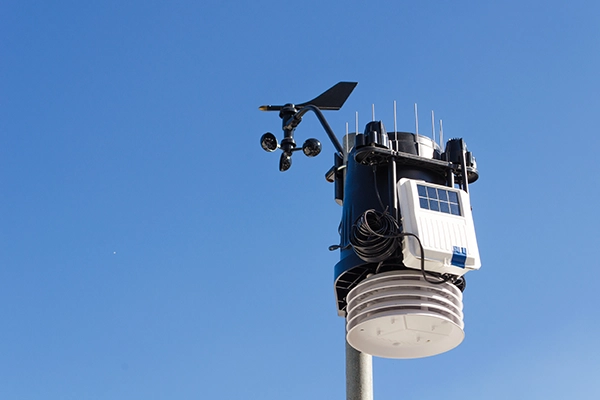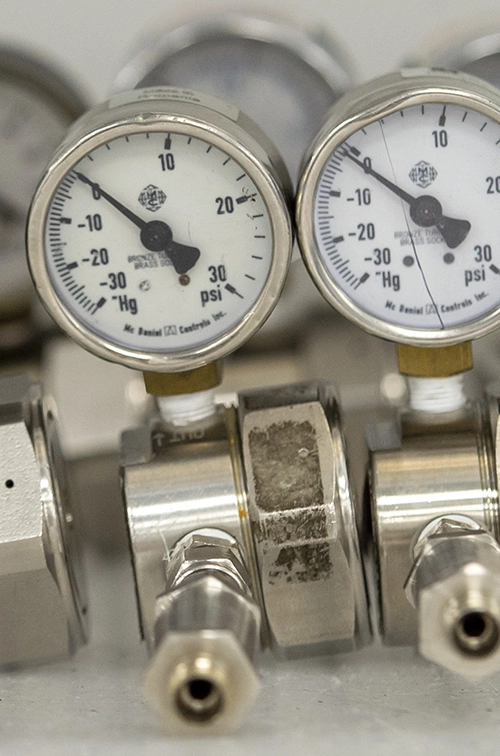Air Quality Permitting And Meteorological Monitoring
Pace® offers a range of customizable solutions and services that support compliance, air quality permit applications, and meteorological monitoring. Our staff of highly skilled engineers, atmospheric scientists, meteorologists, computer scientists, trained technicians, and experienced project managers provide comprehensive, turnkey meteorological and air quality permitting services to our clients. From state-level source permits to Federal Prevention of Significant Deterioration (PSD) to New Source Review (NSR) applications to meteorological monitoring, Pace® brings unique qualifications and capabilities to support any project, no matter how complex.
- Network Site Selection
- Design
- Installation
- Operation and Maintenance
- Data Validation
- Analysis and Interpretation
- Agency Reporting
- Air Quality Permitting
- Air Dispersion Modeling
- NESHAP and NSPS Compliance

What Is Meteorological Monitoring?
Meteorological monitoring is essential for understanding and predicting the dispersion and transport of emissions from various sources, including variables like wind speed, wind direction, temperature, humidity, precipitation, and atmospheric pressure. This analysis can help in assessing the potential impact of those emissions on air quality and in ensuring compliance with air quality regulations.
What Is Air Quality Permitting?
Air quality permitting often involves the use of air dispersion models that rely on meteorological data collected to estimate the concentrations of pollutants at various locations within the area of interest. These models are used to show compliance with regulatory standards. Common air quality permit types include:
- New Source Review (NSR) Permits
- Title V Operating Permits
- Permits by Rule (PBR)
- State Air Permits

Common Meteorologic Monitoring Projects

Meteorological data collection can help businesses, such as manufacturers and solid waste disposal facilities, analyze a potential site before construction begins. Weather patterns, in particular, can influence a site’s suitability for various industrial activities.
An AERMOD-ready tower is equipped with the necessary instrumentation to collect meteorological data, such as wind speed, direction, delta temperature, and solar radiation, which is then inputted into the AERMET preprocessor. This preprocessed meteorological data is used in the AERMOD model to predict the dispersion of air pollutants from various sources and help regulatory agencies, industries, and consultants assess compliance with air quality standards and regulations.
The “Prevention of Significant Deterioration (PSD)" program is part of the U.S. Clean Air Act. This program requires measures be taken to prevent significant deterioration of air quality in areas that exceed the National Ambient Air Quality Standard. Compliance is required to ensure that the operation of a tower does not lead to a significant deterioration in local air quality.
The Nuclear Regulatory Commission (NRC) is a U.S. government agency established by the Energy Reorganization Act of 1974. Its mission includes the regulation of commercial nuclear power reactors, nuclear materials, and waste activities. Compliance with their standards helps ensure that the towers used in the nuclear energy sector are safe and address potential risks related to nuclear power utilization.
Meteorological monitoring is critical in assessing the safety of tall structures under various weather conditions. For instance, wind speed and direction measurements can help determine the structural stability of tall towers and ensure their safe operation. Furthermore, monitoring meteorological conditions helps in the design and implementation of structural health monitoring (SHM) systems, which use sensors to continuously monitor the structure during construction and operation for real-time assessment.
Particularly dependent on weather patterns, meteorological monitoring is especially crucial for renewable energy projects. This data not only helps predict the availability of renewable resources, such as sun and wind, but it can also help predict the environmental impact of the climate and terrain in sensitive equipment.
Meteorological Monitoring Services – From Start To Finish
Pace® is here to support you throughout every stage of your project. Our dedicated project manager will collaborate with your team of facility environmental and process engineers, consultants, and government regulatory agencies to coordinate services and ensure your project goals are met.
Our meteorological monitoring services and support includes:
- Complete turnkey installation and calibration
- Agency negotiations
- Customized real-time web data display and access with secure 24/7 data hosting
- All major brands of sensors
- Telecommunications to meet your project needs
- Site assessments using iterative modeling
- Emissions inventory
- Datalogging systems designed to your needs
- Agency approvals of modeling protocols
- NIST-certified audit and calibration standards
- Very high data recovery meeting industry standards (typically > 90%)


Air Permitting Services
Keeping a project on track requires successfully navigating complex regulatory requirements and securing necessary air permits in a timely fashion while also minimizing operational and financial impacts. With a single point of contact and a dedicated project manager, Pace ® provides support for all phases of the air-permitting process, including:
- Regulatory Applicability Analyses
- Permit Strategy Development
- Permit Application
- Emissions Quantification and Netting Analysis
- Compliance Management
- Compliance Certification Assistance
- Evaluation and Determination of Control Requirements
- Compliance Audits and Assistance
- Emission Inventories (including Greenhouse Gas)
- Dispersion Modeling and Impact Assessment
Meteorological Monitoring And Permitting For The Mining Industry
Pace® meteorological monitoring provides a complete picture of the mining site and surrounding environment. Accurate precipitation, wind, and temperature data keep mining operations running at optimal production and provide real-time data to adjust operations. Pace® meteorological monitoring services also help mining customers comply with permitting requirements at every level. Pace® also supports other industries and organizations, including:
- Refineries
- Power Plants
- Government
- Municipalities
- Tribal Agencies
- Consulting Firms
- Agriculture

The Expertise You Need
ATMOSPHERIC DISPERSION MODELING
As part of the permitting approval process, facility owners are required to evaluate potential air quality impacts. Pace® air modeling services enable you to characterize short- and long-term impacts over the chosen modeling domain. Source emission controls can be incorporated to predict corresponding improvements in ambient air quality. Modeling tools include ISC3 and AERMOD, both based on steady-state pollutant dispersion (gaussian), or CALPUFF, based on time-varying dispersion (lagrangian). These models utilize surface and upper air meteorology from the chosen time domain.
COMPLIANCE, REPORTING, AND QUALITY
The evolving nature of government regulations requires companies to plan for record-keeping and reporting requirements. Pace® delivers accurate and defensible data that can be used in support of environmental assessments, compliance, and permitting. Our quality assurance and quality control programs ensure that your monitoring data meets U.S. EPA, state, and local requirements for completeness, representativeness, precision, and accuracy.
NIST CERTIFICATION
With the creation of environmental monitoring regulations, calibration has become synonymous with documentation. It’s no longer enough to tell you that the device you are purchasing has been calibrated. You must be able to produce a documented process if and when your devices are called into question. Pace® is certified by the National Institute of Standards and Technology (NIST) for audit and calibration. This allows you to rest assured that you are receiving the highest quality data and that all your instrumentation measurements are accurate and defensible.
Additional Resources
Need to find a lab that can handle your unique requirements?
Contact us directly or download our list of environmental certifications across our network.